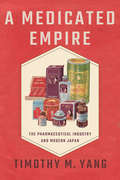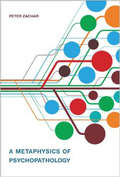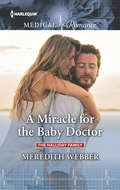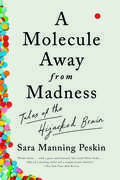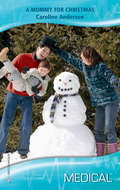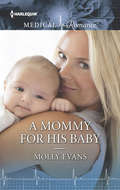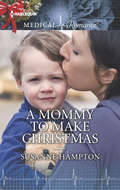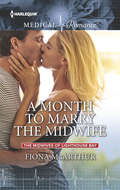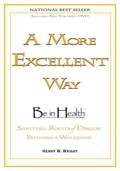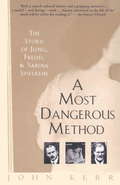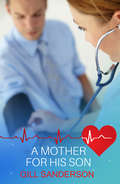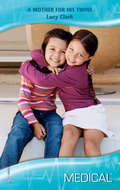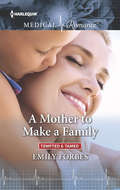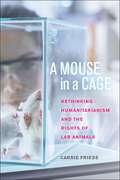- Table View
- List View
A Medicated Empire: The Pharmaceutical Industry and Modern Japan (Studies of the Weatherhead East Asian Institute, Columbia University)
by Timothy M. YangIn A Medicated Empire, Timothy M. Yang explores the history of Japan's pharmaceutical industry in the early twentieth century through a close account of Hoshi Pharmaceuticals, one of East Asia's most influential drug companies from the late 1910s through the early 1950s. Focusing on Hoshi's connections to Japan's emerging nation-state and empire, and on the ways in which it embraced an ideology of modern medicine as a humanitarian endeavor for greater social good, Yang shows how the industry promoted a hygienic, middle-class culture that was part of Japan's national development and imperial expansion. Yang makes clear that the company's fortunes had less to do with scientific breakthroughs and medical innovations than with Japan's web of social, political, and economic relations. He lays bare Hoshi's business strategies and its connections with politicians and bureaucrats, and he describes how public health authorities dismissed many of its products as placebos at best and poisons at worst. Hoshi, like other pharmaceutical companies of the time, depended on resources and markets opened up, often violently, through colonization. Combining global histories of business, medicine, and imperialism, A Medicated Empire shows how the development of the pharmaceutical industry simultaneously supported and subverted regimes of public health at home and abroad.
A Metaphysics of Psychopathology
by Peter ZacharIn psychiatry, few question the legitimacy of asking whether a given psychiatric disorder is real; similarly, in psychology, scholars debate the reality of such theoretical entities as general intelligence, superegos, and personality traits. And yet in both disciplines, little thought is given to what is meant by the rather abstract philosophical concept of "real." Indeed, certain psychiatric disorders have passed from real to imaginary (as in the case of multiple personality disorder) and from imaginary to real (as in the case of post-traumatic stress disorder). In this book, Peter Zachar considers such terms as "real" and "reality" -- invoked in psychiatry but often obscure and remote from their instances -- as abstract philosophical concepts. He then examines the implications of his approach for psychiatric classification and psychopathology. Proposing what he calls a scientifically inspired pragmatism, Zachar considers such topics as the essentialist bias, diagnostic literalism, and the concepts of natural kind and social construct. Turning explicitly to psychiatric topics, he proposes a new model for the domain of psychiatric disorders, the imperfect community model, which avoids both relativism and essentialism. He uses this model to understand such recent controversies as the attempt to eliminate narcissistic personality disorder from the DSM-5. Returning to such concepts as real, true, and objective, Zachar argues that not only should we use these metaphysical concepts to think philosophically about other concepts, we should think philosophically about them.
A Metaphysics of Psychopathology (Philosophical Psychopathology)
by Peter ZacharAn exploration of what it means to think about psychiatric disorders as “real,” “true,” and “objective” and the implications for classification and diagnosis.In psychiatry, few question the legitimacy of asking whether a given psychiatric disorder is real; similarly, in psychology, scholars debate the reality of such theoretical entities as general intelligence, superegos, and personality traits. And yet in both disciplines, little thought is given to what is meant by the rather abstract philosophical concept of “real.” Indeed, certain psychiatric disorders have passed from real to imaginary (as in the case of multiple personality disorder) and from imaginary to real (as in the case of post-traumatic stress disorder). In this book, Peter Zachar considers such terms as “real” and “reality”—invoked in psychiatry but often obscure and remote from their instances—as abstract philosophical concepts. He then examines the implications of his approach for psychiatric classification and psychopathology.Proposing what he calls a scientifically inspired pragmatism, Zachar considers such topics as the essentialist bias, diagnostic literalism, and the concepts of natural kind and social construct. Turning explicitly to psychiatric topics, he proposes a new model for the domain of psychiatric disorders, the imperfect community model, which avoids both relativism and essentialism. He uses this model to understand such recent controversies as the attempt to eliminate narcissistic personality disorder from the DSM-5. Returning to such concepts as real, true, and objective, Zachar argues that not only should we use these metaphysical concepts to think philosophically about other concepts, we should think philosophically about them.
A Mind Unraveled: A Memoir
by Kurt EichenwaldThe compelling story of an acclaimed journalist and New York Times bestselling author’s ongoing struggle with epilepsy—his torturous decision to keep his condition a secret to avoid discrimination, and his ensuing decades-long battle to not only survive, but to thrive. <P><P>As a college freshman, Kurt Eichenwald awoke one night on the floor of his dorm room, confused and in pain. In the aftermath of that critical moment, his once-carefree life would be consumed by confrontations with medical incompetence, discrimination that almost cost him his education and employment, physical abuse, and dark moments when he contemplated suicide. <P><P>This is the story of one man’s battle to pursue his dreams despite an often incapacitating brain disorder. <P><P>From his early experiences of fear and denial to his exasperating search for treatment, Eichenwald provides a deeply candid account of his years facing this misunderstood and often stigmatized condition. He details his encounters with the doctors whose negligence could have killed him, but for the heroic actions of a brilliant neurologist and the family and friends who fought for him. <P><P>Many of Eichenwald’s recollections are drawn from his diaries, vivid and painstakingly kept records that helped sharpen his skills as a journalist. He raises important questions about the nature of memory, the revelations of brain science, and the profound mysteries of human perception. <P><P>Ultimately, A Mind Unraveled is an inspirational story, one that chronicles how Eichenwald, faced often with his own mortality, transformed trauma into a guide for reaching the future he desired. Defying relentless threats to his emotional and physical well-being, he affirmed his decision to never give up, and in the process learned how to rise from the depths of despair to the heights of unimagined success.
A Miracle and A Privilege: RECOUNTING A HALF CENTURY OF SURGICAL ADVANCE
by Francis D. MooreFrancis Moore entered Harvard Medical School in September of 1935, seven years before penicillin became available. During his remarkable career in surgery, research, and education, Moore has witnessed and contributed to some of the most important biomedical advances of the century, and his students now practice surgery worldwide. In this autobiography, he brings humor and warmth to the story of a lifetime at the forefront of medicine.In this fascinating book Moore describes his work in radioactive isotope research, burn therapy, breast cancer treatment, transplant science, and understanding the process of convalescence.Moore's colleagues have included such medical pioneers as George Thorn, David Hume, Thomas Starzl, John Gibbon, Steven Rosenberg, Harold Urey, and Nobel Prize winner Joseph Murray, and he recounts the setbacks and victories of their work. For example, he writes of the adventure he had with Charles Hufnagel in which 25 dogs, implanted with Hufnagel's experimental heart valves, made their escape into the Connecticut countryside and had to be recovered by dog control officers wielding stethoscopes.Yet Moore recalls with equal clarity the young mother who gave him a silver dollar for delivering her baby, the husband who begged that his ailing wife be allowed to die with dignity, and the desperately sick patients who made themselves available for experimental surgery and treatment. In one of his early operations he relieved "the pain, anguish, and threat to a wonderful small boy" by removing the boy's diseased appendix. He describes this capability as "a miracle and a privilege."The book includes a gripping account of the aftermath of the Cocoanut Grove nightclub fire in Boston in 1942, when Moore learned the horrific details of death by fire. He recounts both his experience with M.A.S.H. units and battalion aid stations in Korea and the sudden request from the U.S. State Department that resulted in his treating King Ibn Saud of Saudi Arabia.Moore's life story reflects his serious commitment to human well-being as well as his appreciation for the wonder of human life. Physicians, medical students, and all readers alike will find this book informative and inspirational.Francis Daniels Moore, M.D., is Moseley Professor of Surgery, Emeritus, Harvard Medical School and Surgeon-in-Chief, Emeritus, Peter Bent Brigham Hospital, Boston.
A Miracle for the Baby Doctor
by Meredith WebberConceived in paradise... When beautiful embryologist Fran Hawthorne is offered the opportunity to work on a Pacific island for a month, she seizes the chance to escape the humiliation of her ex-husband's betrayal. But Fran isn't prepared for Steve Ransome, the handsome doctor heading the clinic. After years of struggling to conceive with her ex, Fran is tempted to give in to the pure passion that burns between them. Only their "temporary" fling results in her carrying the child she thought she'd never have...
A Mistake: A Novel
by Carl ShukerIn medicine, a single mistake in an otherwise spotless career can determine the rest of your life—even if the mistake was not your ownElizabeth Taylor is a gifted surgeon—the only female consultant at her hospital. But while operating on a young woman with life–threatening blood poisoning, something goes horribly wrong. In the midst of a new scheme to publicly report surgeons' performance, her colleagues begin to close ranks, and Elizabeth's life is thrown into disarray. Tough and abrasive, Elizabeth has survived and succeeded in this most demanding, palpably sexist field. But can she survive a single mistake?A Mistake is a page–turning procedural thriller about powerful women working in challenging spheres. The novel examines how a survivor who has successfully navigated years of a culture of casual sexism and machismo finds herself suddenly in the fight of her life. When a mistake is life–threatening, who should ultimately be held responsible? Carl Shuker has produced some of the finest writing on the physicality of medical intervention, where life–changing surgery is detailed moment by moment in a building emergency. A Mistake daringly illustrates the startling mix of the coolly intellectual and deeply personal inherent in the life and work of a surgeon.
A Mistletoe Kiss for the Single Dad: The Nurse's Christmas Temptation / A Mistletoe Kiss For The Single Dad (Mills And Boon Medical Ser.)
by Traci DouglassSecond Chance……under the mistletoe!GP Nick Marlowe returned to his hometown to focus on raising his young son. The last person he expects to see in Bayside is high-flying Beverly Hills surgeon Belle! The childhood sweetheart he let go so she could pursue her dream of attending medical school. Only working side-by-side to reopen her late aunt’s free Christmas Eve clinic their magical connection returns... Could a mistletoe kiss spark another chance—just in time for Christmas?“This is the third book I’ve now read by Ms. Douglass and I’ve got to say that she pens such heartfelt and wonderful stories….and I loved the path this couple took from start to finish. The way this story started drew me into the story immediately and had me reading quickly….”— Harlequin Junkie on Finding Her Forever Family“…Ms. Douglass has delivered an absolutely engaging and unputdownable read in this book…the chemistry between this couple was powerful; the romance was nicely-detailed and had me loving the special connection these two have….”— Harlequin Junkie on One Night with the Army Doc
A Modal Approach to the Space-Time Dynamics of Cognitive Biomarkers (Synthesis Lectures on Biomedical Engineering)
by Tristan D. Griffith James E. Hubbard Jr. Mark J. BalasThis book develops and details a rigorous, canonical modeling approach for analyzing spatio-temporal brain wave dynamics. The nonlinear, nonstationary behavior of brain wave measures and general uncertainty associated with the brain makes it difficult to apply modern system identification techniques to such systems. While there is a substantial amount of literature on the use of stationary analyses for brain waves, relatively less work has considered real-time estimation and imaging of brain waves from noninvasive measurements. This book addresses the issue of modeling and imaging brain waves and biomarkers generally, treating the nonlinear and nonstationary dynamics in near real-time. Using a modal state-space formulation leads to intuitive, physically significant models which are used for analysis and diagnosis.A Modal Approach to the Space-Time Dynamics of Cognitive Biomarkers provides a much-needed reference for practicing researchers in biomarker modeling leveraging the lens of engineering dynamics.
A Modern Approach to Biofilm-Related Orthopaedic Implant Infections: Advances in Microbiology, Infectious Diseases and Public Health Volume 5 (Advances in Experimental Medicine and Biology #971)
by Lorenzo DragoThis book discusses Prosthetic Joint Infection (PJI), which remains one of the most common problems necessitating revision arthroplasty. It pursues a multidisciplinary approach, bringing together opinions from the leading experts in the field. The book identifies the potential causes of these infections, provides sound diagnostic criteria guidelines, and explains how these prosthetic infections are managed from orthopedic surgery, clinical and diagnostic perspectives. PJI can lead to multiple revision surgeries and significant patient morbidity. Periprosthetic infection rates remain around 1-2% after primary total hip and knee arthroplasty and account for approximately 7-12% of all revision cases. Orthopedic hardware infections are much-feared and costly complications that can occur when these devices are implemented both in traumatic cases as well as in joint replacement surgery. Because these infections can lead to higher morbidity, it is important to understand their pathophysiology and the principles behind their diagnosis and initial treatment. The pathogenesis of these kinds of infections is intimately connected to the biofilm-producing trait characteristic of many microorganisms, which can have a critical effect on the likely success of treatments. The book offers a unique guide for all scientists working in arthroplasty who are seeking an update on the field, and for newcomers alike.
A Modern Contagion: Imperialism and Public Health in Iran's Age of Cholera
by Amir A. AfkhamiHow deadly cholera pandemics transformed modern Iran.Pandemic cholera reached Iran for the first of many times in 1821, assisted by Britain's territorial expansion and growing commercial pursuits. The revival of Iran's trade arteries after six decades of intermittent civil war, fractured rule, and isolation allowed the epidemic to spread inland and assume national proportions. In A Modern Contagion, Amir A. Afkhami argues that the disease had a profound influence on the development of modern Iran, steering the country's social, economic, and political currents.Drawing on archival documents from Iranian, European, and American sources, Afkhami provides a comprehensive overview of pandemic cholera in Iran from the early nineteenth century to the First World War. Linking the intensity of Iran's cholera outbreaks to the country's particular sociobiological vulnerabilities, he demonstrates that local, national, and international forces in Iran helped structure the region's susceptibility to the epidemics. He also explains how Iran's cholera outbreaks drove the adoption of new paradigms in medicine, helped transform Iranian views of government, and caused enduring institutional changes during a critical period in the country's modern development.Cholera played an important role in Iran's globalization and diplomacy, influencing everything from military engagements and boundary negotiations to Russia and Britain's imperial rivalry in the Middle East. Remedying an important deficit in the historiography of medicine, public health, and the Middle East, A Modern Contagion increases our understanding of ongoing sociopolitical challenges in Iran and the rest of the Islamic world.
A Molecule Away from Madness: Tales Of The Hijacked Brain
by Sara Manning PeskinLonglisted for the PEN/E.O. Wilson Literary Science Writing Award Riveting stories of the brain on the brink, from an acclaimed cognitive neurologist. Our brains are the most complex machines known to humankind, but they have an Achilles heel: the very molecules that allow us to exist can also sabotage our minds. Here are gripping accounts of unruly molecules and the diseases that form in their wake. A college student cannot remember if she has eaten breakfast. By dinner, she is strapped to a hospital bed, convinced she is battling zombies. A man planning to propose marriage instead becomes violently enraged, gripped by body spasms so severe that he nearly bites off his own tongue. One after another, poor farmers in South Carolina drop dead from a mysterious epidemic of dementia. With an intoxicating blend of history and intrigue, Sara Manning Peskin invites readers to play medical detective, tracing each diagnosis from the patient to an ailing nervous system. Along the way, Peskin entertains with tales of the sometimes outlandish, often criticized, and forever devoted scientists who discovered it all. Peskin never loses sight of the human impact of these conditions. Alzheimer’s Disease is more than the gradual loss of a loved one; it can be a family’s multigenerational curse. The proteins that abound in every cell of our bodies are not simply strings of oxygen, hydrogen, nitrogen, and carbon; they are the building blocks of our personalities and relationships. A Molecule Away from Madness is an unputdownable journey into the deepest mysteries of our brains.
A Mommy for Christmas
by Caroline AndersonSpecialist Kate Burgess is intrigued. Her gorgeous new surgeon James McEwan is so talented--but why is he always late? Because, she discovers, he's alone with two small children. Kate's heartstrings are well and truly pulled, and when James finds himself temporarily homeless Kate can't stop herself offering help. James's kids blossom with the love and support of Kate and her large extended family, and he just wishes she could be part of his. Then James realizes that Kate wants children of her own--does she need them as much as they need her? If he asks her to marry him maybe this Christmas all their dreams can come true!
A Mommy for His Baby: A Single Dad Romance
by Molly EvansThe nurse to heal his family? When Aurora Hunt returns home after an accident nursing more than physical wounds, she needs local GP and childhood crush Beau Gutterman to help her. Only she hasn't counted on his offer of a job...or the attraction that reignites between them! Recently widowed Beau is bringing up his baby daughter alone, and Aurora's arrival is a gift. He's not ready to move on, but working with Aurora stirs long-buried desires. Can they really heal each other's hearts-and make a family for baby Chloe?
A Mommy for His Daughter: Bound By Their Babies A Mommy For His Daughter Reunited By Their Baby
by Amy RuttanShe’s never had a chance at a family…But could happiness be found where she least expected?Dr. Evelyn Saunders left her orphan past behind, along with the cold Alaskan climes of Wolf’s Harbor. But an unexpected posting back home brings her up close and personal with single dad GP Derek Taylor. Neither are looking for love, but could this doting dad and his little girl bring Evelyn the happy family she’s longed for?
A Mommy to Make Christmas
by Susanne HamptonChristmas wish come true... Dr. Phoebe Johnson might have sworn off all men, and moved all the way to Australia to escape her cheating fiancé, but her new boss-dashing Dr. Heath Rollins-is just so hard to resist... Single dad Heath's sole focus is his precious son, Oscar. Yet every year his little son wishes for a mommy. Now, with vivacious Phoebe igniting a fire in Heath's heart and opening his eyes to a whole new world, could all their dreams come true this Christmas?
A Month to Marry the Midwife
by Fiona McarthurFalling for the midwife Midwife Ellie Swift has devoted herself to beautiful Lighthouse Bay's tiny hospital. After a painful divorce, she's vowed never to get involved with another man-but then the sexy new locum obstetrician walks through the door! Despite his own damaged heart, Sam Southwell is captivated by Ellie's warmth and compassion. She's a woman who deserves a fairy tale! It won't be easy to change her mind, but Sam's never walked away from a challenge...
A More Excellent Way: Be In Health
by Henry W. WrightThe root of psychological and biological disease is spiritual. Author Henry W. Wright not only equips the church with respect to defeating sickness, but he also demystifies it by showing, from God's perspective, why mankind has disease in the first place. A More Excellent Way is a valuable resource in assisting spiritual leaders, health-care professionals, and all individuals in understanding the spiritual dynamics behind diseases of the body, spirit, and soul.
A Most Dangerous Method
by John KerrThis explosive, revelatory history of the early years of psychoanalysis shows that the bitterly unresolvable split between Jung and Freud pivoted around a former patient and lover of Jung's whose story and own potentially important theoretical contributions to psychoanalysis were blocked by both men. "A huge scholarly work . . . gripping". --The New York Times.
A Mother for His Son: A Delightful Medical Romance (Medical Romances #2)
by Gill SandersonAnother heartwarming medical romance from best-selling author Gill Sanderson! Perfect for fans of Mia Faye, Laura Scott, Helen Scott Taylor, Grey's Anatomy and ER.Readers ADORE Gill's gripping medical romances!'Remarkable writer!!' 5* author review 'A truly wonderful writer' 5* author review 'I find all of Gill Sanderson's books very readable and enjoy the escapism they give me' 5* author review 'A truly gifted writer with an enormous amount of talent and sensitivity' 5* author review All it took was a near fatal accident to persuade them that risks really were worth taking...GP Cat Fraser left London to seek peace after the death of her nephew. It hadn't been her fault but the guilt bit deeply into her.Medicine in a small Lake District hospital was vastly different from what she had been accustomed to. She came to love the surroundings and the community feeling. She found them comforting. Also comforting and uncomfortable was her relationship with Dr Ross McCain and his four-year-old son Stephen. What was she to do?Both Cat and Ross were wary. Both had been hurt, were unwilling to risk further pain. They started a love affair - but agreed it was only a fling.Don't miss Gill Sanderson's enthralling medical romances, including the A Lakeland Practice and the Good, Bad and Ugly series.
A Mother for His Son: A Delightful Medical Romance (Medical Romances Ser.)
by Gill SandersonAnother heartwarming medical romance from best-selling author Gill Sanderson! Perfect for fans of Mia Faye, Laura Scott, Helen Scott Taylor, Grey's Anatomy and ER.Readers ADORE Gill's gripping medical romances!'Remarkable writer!!' 5* author review 'A truly wonderful writer' 5* author review 'I find all of Gill Sanderson's books very readable and enjoy the escapism they give me' 5* author review 'A truly gifted writer with an enormous amount of talent and sensitivity' 5* author review All it took was a near fatal accident to persuade them that risks really were worth taking...GP Cat Fraser left London to seek peace after the death of her nephew. It hadn't been her fault but the guilt bit deeply into her.Medicine in a small Lake District hospital was vastly different from what she had been accustomed to. She came to love the surroundings and the community feeling. She found them comforting. Also comforting and uncomfortable was her relationship with Dr Ross McCain and his four-year-old son Stephen. What was she to do?Both Cat and Ross were wary. Both had been hurt, were unwilling to risk further pain. They started a love affair - but agreed it was only a fling.Don't miss Gill Sanderson's enthralling medical romances, including the A Lakeland Practice and the Good, Bad and Ugly series.
A Mother for His Twins
by Lucy ClarkDay one in Paramatta's E. R. and surgical director Jennifer Thorngate's head is spinning -- she's just met gorgeous surgeon Jasper Edwards! Simply being near him makes her sizzle. But Jennifer is determined not to allow her personal and professional worlds to collide. Her resolve is tested to the limit when she meets Jasper's little girls. Watching the loving single dad with his twins puts the smile back on Jennifer's face . . . a smile that brings Jasper's heart back to life.
A Mother to Make a Family
by Emily ForbesA fresh start in the outback... When Dr. Mitch Reynolds lost his wife, he blamed himself and turned his back on medicine. He keeps his three children close but the world at a distance. But then Rose Anderson walks into his life... Teacher Rose always dreamed of falling in love, but after an illness left her scarred, her dreams feel further away than ever. Yet helping Mitch's little family become whole again gives her the chance to belong and the prospect of being loved...just as she is.
A Mouse in a Cage: Rethinking Humanitarianism and the Rights of Lab Animals
by Carrie FrieseQuestions the treatment of laboratory animals in biomedical researchLaboratory animals are often used to develop medical treatments: vaccines, antibiotics, and organ transplants have all relied upon animal testing to ensure safety and success for human benefit. Yet the relationship between the scientific community's dependence on laboratory animals and the recognition of the need to treat these animals with respect and compassion has given rise to a profound tension.As animals are increasingly understood to have rights and autonomy, Carrie Friese posits that, while care and compassion for a distant other who suffers are central to humanitarianism, the idea of a distant other itself, which has shaped work with laboratory animals both historically and today, has enacted forms of highly problematic paternalism, creating a double bind. Focusing on the lives of laboratory mice and rats in the United Kingdom, and on the people who take care of, and often kill, these animals, Friese gives the name of “more-than-human humanitarianism” to contradictory practices of suffering and compassion, killing and sacrifice, and compassion and consent that she witnessed in a variety of animal facilities and laboratories.Friese proposes a new approach to the treatment of laboratory animals that recognizes the interconnectedness of all species and how human actions impact the welfare of other species and the planet as a whole. A Mouse in a Cage is an essential contribution to the ongoing conversation about the ethical treatment of animals.
A Multidisciplinary Approach to Capability in Age and Ageing (International Perspectives on Aging #31)
by Hanna Falk Erhag Ulrika Lagerlöf Nilsson Therese Rydberg Sterner Ingmar SkoogThis open access book provides insight on how to interpret capability in ageing – one’s individual ability to perform actions in order to reach goals one has reason to value – from a multidisciplinary approach. With for the first time in history there being more people in the world aged 60 years and over than there are children below the age of 5, the book describes this demographic trends as well as the large global challenges and important societal implications this will have such as a worldwide increase in the number of persons affected with dementia, and in the ratio of retired persons to those still in the labor market. Through contributions from many different research areas, it discussed how capability depends on interactions between the individual (e.g. health, genetics, personality, intellectual capacity), environment (e.g. family, friends, home, work place), and society (e.g. political decisions, ageism, historical period). The final chapter summarizes the differences and similarities in these contributions. As such this book provides an interesting read for students, teachers and researchers at different levels and from different fields interested in capability and multidisciplinary research.
